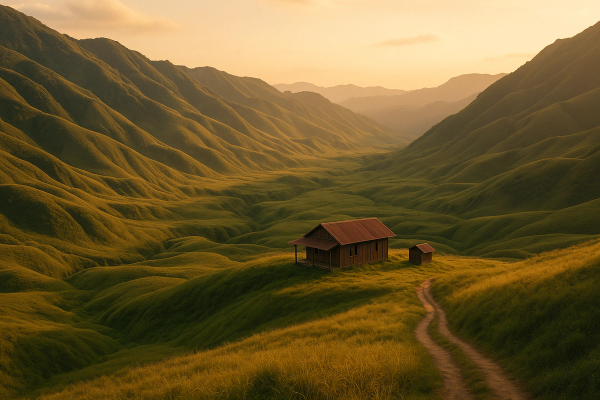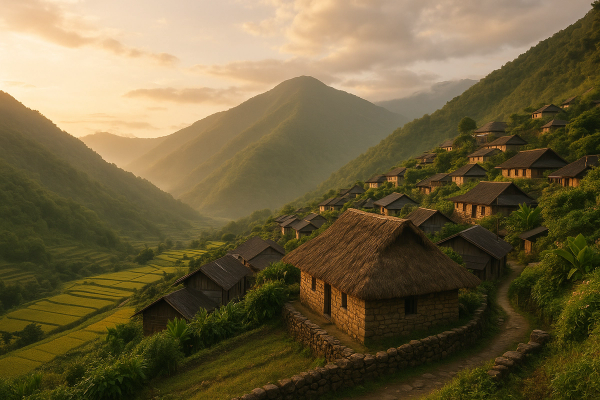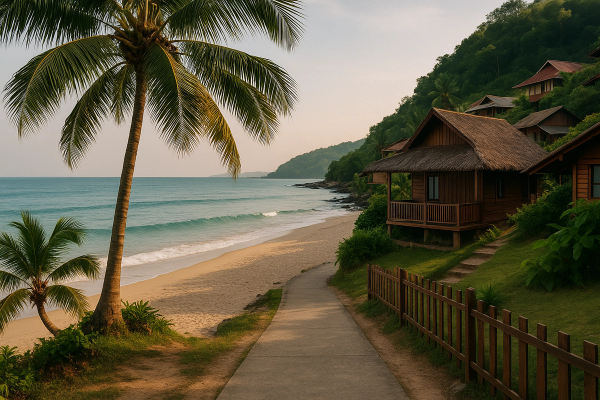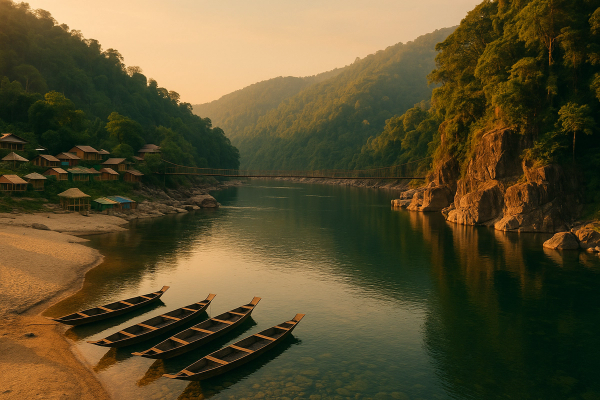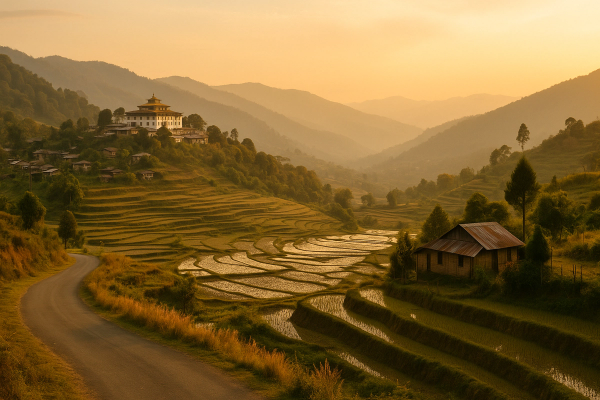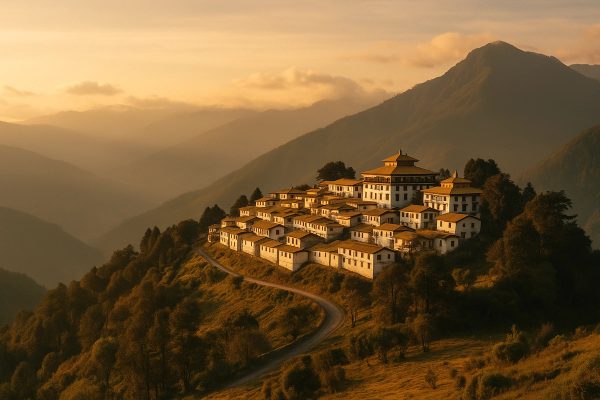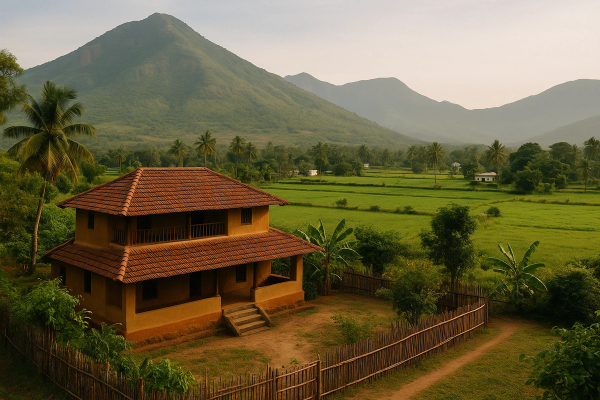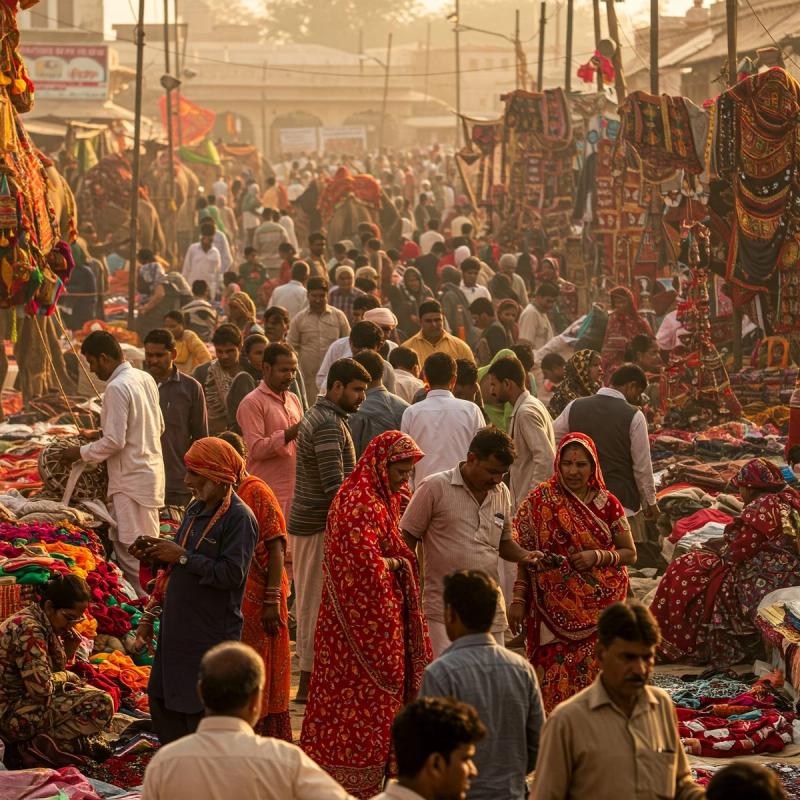
Desert Drums and Rajasthani Dreams: Your First-Timer's Guide to the Pushkar Camel Fair#
Imagine this: the golden desert sands of Rajasthan stretch before you, alive with a riot of colour, sound, and energy. Thousands of camels, adorned in vibrant tassels, grunt and sway. Mustachioed traders haggle passionately, their voices mingling with the hypnotic melodies of folk musicians. The air hangs thick with the scent of spices, dust, and sizzling street food. This isn't just a marketplace; it's a living, breathing spectacle – the legendary Pushkar Camel Fair. For first-timers, stepping into this whirlwind can feel overwhelming, but trust me, it's an immersion into the heart of Rajasthani culture unlike any other. This Pushkar Camel Fair guide for first timers is your key to unlocking the magic, navigating the beautiful chaos, and creating memories that will last a lifetime.¶
Held annually in the tiny, sacred town of Pushkar, this event is far more than just a camel trading meet. It's a vibrant confluence of commerce, culture, religion, and incredible photography opportunities, drawing visitors from across India and the globe. If cultural travel and experiencing authentic festivals are high on your list, the Pushkar Mela (as it's locally known) is an absolute must-do on any Rajasthan itinerary.¶
Pushkar: The Sacred Oasis Hosting the Spectacle#
Before diving into the fair itself, let's understand its host town. Pushkar, nestled beside a holy lake in the Ajmer district of Rajasthan, is one of India's oldest and most sacred Hindu pilgrimage sites. Legend holds that the lake was created when Lord Brahma, the creator god in Hinduism, dropped a lotus flower.¶
Key features of Pushkar town include:¶
- Pushkar Lake: The spiritual heart of the town, surrounded by 52 bathing ghats (steps leading down to the water) where pilgrims perform sacred rituals.
- Jagatpita Brahma Mandir: One of the very few temples in the world dedicated to Lord Brahma. A major pilgrimage destination.
- Vibrant Markets: Narrow lanes brimming with shops selling colourful textiles, silver jewellery, leather goods, and Rajasthani crafts.
- Atmosphere: A unique blend of devout spirituality and laid-back traveller vibes (outside of the fair's intensity!). It's a strictly vegetarian town, and alcohol is officially prohibited due to its religious significance.
Understanding Pushkar's spiritual context is crucial for appreciating the layers of the fair, as the event culminates on the holy full moon night of Kartik Purnima.
When Does the Magic Happen? Pushkar Camel Fair Dates#
This is the most crucial piece of planning! The Pushkar Camel Fair dates change every year because they are determined by the Hindu lunar calendar. The fair typically takes place over several days (usually 7-9 days, sometimes longer with lead-up activities) in the Hindu lunar month of Kartik, culminating on the full moon night, Kartik Purnima.¶
Generally, this falls sometime between late October and late November in the Gregorian calendar. The main trading activities happen in the initial days, while the cultural events, competitions, and religious festivities intensify towards the full moon.¶
Why the Timing Matters#
The fair's timing coincides with one of the most auspicious times for Hindus to bathe in the sacred Pushkar Lake. This adds a deeply spiritual dimension to the event. Thousands of pilgrims flock to the town alongside tourists and traders, creating an incredible, albeit crowded, atmosphere.¶
Actionable Tip: Always check the official dates announced by Rajasthan Tourism (or reliable travel operators) well in advance before booking flights or accommodation. Searching 'Pushkar Fair dates [Year]' is essential.
Weather-wise, late October/November usually offers pleasant daytime temperatures in Rajasthan, though evenings and early mornings can be surprisingly cool. It's generally dry, but dust is a constant companion!¶
What Actually Happens at the Pushkar Camel Fair?#
Prepare for sensory overload in the best possible way! The fairgrounds, located on the outskirts of Pushkar town in the desert sands, transform into a bustling metropolis. Here's a breakdown of what unfolds:¶
The Livestock Trading (Camels, Horses, Cattle)#
This is the fair's genesis. Thousands of camels, horses, and cattle are brought here by traders from across Rajasthan and neighbouring states. Witnessing the traditional haggling, the inspection of animals, and the sheer scale of the gathering is fascinating. You'll see camels decorated with intricate shaving patterns and colourful adornments.¶
- Early Mornings: The best time to see the trading activity and capture atmospheric photos in the soft light.
- Respectful Observation: Remember this is serious business for the traders. Observe respectfully from a distance unless engaging politely.
Cultural Performances and Competitions#
The fair is a showcase of vibrant Rajasthani culture. An arena often hosts scheduled events, but impromptu performances pop up everywhere.¶
- Folk Music & Dance: Expect haunting melodies from traditional instruments like the ravanahatha and energetic performances of dances like the Kalbelia (snake charmer dance) and Ghoomar.
- Camel Races & Dances: A major highlight, often chaotic and hilarious. Camels aren't exactly graceful dancers, but it's entertaining!
- Competitions: Look out for unique contests like turban tying (pagri tying), longest moustache competitions, bridal competitions, and tug-of-war matches (sometimes even foreigners vs. locals!).
- Puppet Shows: Traditional Rajasthani puppetry (kathputli) tells ancient tales.
Religious Significance & Activities#
As Kartik Purnima approaches, the focus shifts towards the spiritual.¶
- Holy Dip: Thousands of pilgrims bathe in Pushkar Lake at dawn on the full moon day, believed to wash away sins.
- Temple Visits: Devotees throng the Brahma Temple and other temples around the lake.
- Deep Daan: In the evenings leading up to and on Kartik Purnima, small lamps (diyas) are floated on the lake, creating a breathtakingly beautiful spectacle.
The Mela (Market) Madness#
Beyond the livestock, a massive market springs up selling everything imaginable:¶
- Handicrafts: Textiles (tie-dye, block prints), silver jewellery, leather goods (bags, shoes), puppets, miniature paintings.
- Food Stalls: Offering Rajasthani snacks, sweets, and endless cups of chai.
- Camel Gear: Saddles, decorations, bells.
- General Goods: From household items to agricultural tools.
Bargaining is expected in the market stalls, but always do so politely and with a smile. Start at around 50-60% of the quoted price and meet somewhere in the middle.
Unrivalled Photography Opportunities#
For photographers, Pushkar Fair is paradise. The colours, the textures, the expressive faces, the dramatic desert light... it's overwhelming.¶
- Portraits: Capture the weathered faces of traders, colourful attire of women, adorned sadhus (holy men). Always ask permission first!
- Landscapes: The sight of thousands of camels against the dunes at sunrise or sunset is iconic.
- Action Shots: Camel races, dancers, market chaos.
- Details: Focus on textures, decorations, handicrafts.
Getting to Pushkar and Navigating the Fair#
Reaching Pushkar requires a bit of planning, especially during the peak fair season.¶
Getting There#
- By Air: The nearest airport with good connectivity is Jaipur International Airport (JAI), about 150 km (3-4 hours drive) away. Kishangarh Airport (KQH) is much closer (around 40 km, 1 hour drive) but has fewer flight options.
- By Train: The closest major railway station is Ajmer Junction (AII), just 15 km away. Ajmer is well-connected to major Indian cities like Delhi, Mumbai, Jaipur. From Ajmer station, you can take a taxi or a local bus to Pushkar (approx. 30-45 mins). Book train tickets well in advance via the IRCTC website or app.
- By Road: Pushkar is accessible by road. Government and private buses run from major Rajasthani cities like Jaipur, Jodhpur, Udaipur, and Ajmer. You can also hire a private taxi, which offers more comfort and flexibility but is more expensive.
Insider Tip: Pre-booking taxis or arranging transport from Ajmer to Pushkar is highly recommended during the fair, as demand skyrockets and prices inflate significantly.
Getting Around During the Fair#
- On Foot: The best way to experience the fairgrounds and Pushkar town itself is by walking. Be prepared for uneven sandy terrain and lots of walking!
- Auto-rickshaws: Available for longer distances, like between the town and the far ends of the fairgrounds. Negotiate fares before starting your journey, as meters are rarely used, and prices will be higher during the fair.
- Camel/Horse Carts: Sometimes available for short rides within the fairgrounds – a novel experience but ensure the animal looks healthy.
Traffic restrictions are often put in place in Pushkar town during the fair, making walking the most practical option within the central areas.¶
Where to Stay: Accommodation Tips for the Pushkar Fair#
Accommodation during the Pushkar Camel Fair requires early booking – think 6 months to a year in advance, especially for popular options. Prices are significantly higher than usual.¶
Accommodation Types#
- Desert Camps/Tent Cities: The most atmospheric option! Temporary camps are set up near the fairgrounds, ranging from basic tents to luxurious Swiss tents with attached bathrooms and gourmet meals. This offers direct immersion but can be noisy and dusty. Examples include Orchard Tents, Sky Waltz Camp, various camps set up by RTDC (Rajasthan Tourism Development Corporation). Price Range: $$-$$$$
- Guesthouses & Budget Hotels: Pushkar town has numerous small, family-run guesthouses and basic hotels. These offer a more local experience and are generally cheaper, but standards vary. Book well-known ones based on recent reviews. Price Range: $-$$
- Mid-Range & Heritage Hotels: Several comfortable hotels and beautifully restored havelis (traditional mansions) offer better amenities. Located in or around Pushkar town. Price Range: $$-$$$
- Staying in Ajmer: Some visitors choose to stay in nearby Ajmer (15 km away) where more hotel options are available across budgets, and commute daily. This offers respite from the fair's intensity but involves daily travel. Price Range: $-$$$$
| Accommodation Type | Vibe | Typical Price Range (Fair Time) | Best For |
|---|---|---|---|
| Desert Camps | Immersive, atmospheric, potentially noisy/dusty | $$ - $$$$ | Full immersion, photographers, experience seekers |
| Pushkar Guesthouses | Local, basic, central (in town) | $ - $$ | Budget travelers, backpackers, cultural interaction |
| Pushkar Hotels/Havelis | Comfortable, better amenities, can be quieter | $$ - $$$ | Families, couples seeking comfort, longer stays |
| Ajmer Hotels | Wider range, escape the crowds | $ - $$$$ | Those prioritizing comfort/quiet, larger hotel chains |
Key Takeaway: Book EARLY! Accommodation is the biggest logistical challenge for the Pushkar Fair. Use reputable booking sites or contact properties directly months ahead.
Navigating the Throngs: Tips for Handling the Crowds#
Let's be honest: the Pushkar Camel Fair gets incredibly crowded, especially towards Kartik Purnima. It's part of the experience, but can be intense for first-timers.¶
- Go Early or Late: Visit the fairgrounds early morning (sunrise to 9 am) or late afternoon (4 pm onwards) to avoid the peak heat and the densest crowds.
- Patience is Key: Accept that moving around will be slow. Embrace the chaos rather than fighting it.
- Stay Aware: Keep track of your belongings. Wear bags securely in front of you. Be mindful of your surroundings, especially in tight crowds.
- Hydrate: Carry water (preferably in a reusable bottle) and drink frequently. The desert sun and dust are dehydrating.
- Landmarks: Note key landmarks (like the Ferris wheel or main arena) to orient yourself within the sprawling fairgrounds.
- Take Breaks: Retreat to your accommodation or a quieter cafe in town when you feel overwhelmed.
- Consider a Guide (Initially): Hiring a licensed local guide for your first couple of hours can help you get oriented and understand the layout, though be clear about your expectations and agree on a price beforehand.
Cultural Sensitivity: Respecting Local Customs in Pushkar#
Experiencing the Pushkar Fair authentically means being a respectful guest. Remember, Pushkar is a holy town, and the fair attracts people from diverse traditional backgrounds.¶
Dress Code#
- Modesty is Crucial: Both men and women should dress conservatively, especially when in Pushkar town, near the lake, or visiting temples. This means covering shoulders, cleavage, and knees. Loose-fitting trousers or long skirts/dresses and tops with sleeves are ideal.
- Scarf/Shawl: A lightweight scarf is invaluable for women – useful for extra shoulder coverage, sun/dust protection, and covering your head if entering certain religious areas.
- At the Fairgrounds: While slightly more relaxed, modest dress is still recommended and appreciated.
Photography Etiquette#
- ALWAYS Ask Permission: Before taking close-up photos of people (traders, pilgrims, women, children, sadhus), always ask politely first. A simple gesture (pointing to your camera and raising eyebrows inquiringly) often works if language is a barrier. Respect their decision if they decline.
- No Photos While Bathing: Do not take photos of people bathing in the sacred lake ghats. This is considered highly disrespectful.
- Sadhus (Holy Men): Some may expect a small payment ('dakshina') if you photograph them. Clarify beforehand if possible, or offer a small amount respectfully if you take a picture.
General Behaviour#
- Respect Religious Sites: Remove shoes before entering temples, guesthouses, or homes. Dress modestly. Avoid loud behaviour near the lake and temples.
- Public Displays of Affection: Keep PDA to a minimum; it's not common in public in traditional Indian settings.
- Greetings: A simple 'Namaste' (palms pressed together) with a smile is the standard polite greeting.
- Left Hand: Traditionally, the left hand is considered unclean. Use your right hand for eating, giving/receiving items, and shaking hands (if offered).
- Touts & Scams: Be polite but firm in declining unwanted services or persistent touts. Be wary of anyone approaching you with overly elaborate stories or offers that seem too good to be true.
Cultural sensitivity isn't just about rules; it's about showing genuine respect and curiosity. Your efforts will be appreciated and lead to more meaningful interactions.
A Taste of Rajasthan: Food and Drink at the Fair#
While Pushkar town is strictly vegetarian, the fairgrounds offer a bustling street food scene. It's a great chance to sample local Rajasthani flavours.¶
- Chai: You'll find ubiquitous stalls selling sweet, milky, spiced tea (chai) – perfect for chilly mornings or evening breaks.
- Snacks: Look for kachori (fried pastry filled with lentils/onions), samosas (fried pastry with potato filling), pakoras (vegetable fritters), and poha (flattened rice dish).
- Sweets: Try malpua (syrup-soaked pancakes, often served with rabri - thickened sweet milk), jalebi (crispy syrup-filled spirals), and gulab jamun (milk solid balls in syrup).
- Meals: Simple vegetarian thalis (platters with rice, roti, dal, vegetables) might be available at some larger food stalls or eateries on the periphery.
Food Safety Tips#
- Eat Hot & Fresh: Opt for food that is freshly cooked and served hot.
- Busy Stalls: Choose stalls that are popular with locals – usually a good sign of quality and freshness.
- Bottled Water: Stick to sealed bottled water. Avoid ice unless you're sure it's made from purified water.
- Wash Hands: Carry hand sanitizer and use it frequently before eating.
Essential Practical Tips for Your First Pushkar Fair#
A little preparation goes a long way in making your Pushkar experience smoother.¶
Packing Essentials#
- Clothing: Light layers (t-shirts, long-sleeved shirts), warmer layer (fleece/jacket) for evenings/mornings, modest trousers/long skirts, comfortable walking shoes (closed-toe recommended due to dust/sand), scarf/shawl.
- Health: Sunscreen (high SPF), sunglasses, wide-brimmed hat, basic first-aid kit (band-aids, antiseptic wipes, pain relievers, stomach remedies), hand sanitizer, face mask (for dust).
- Gear: Camera, extra batteries, memory cards, power bank (charging can be tricky), universal travel adapter.
- Documents: Passport, Indian Visa (check requirements for your nationality well in advance), flight/train tickets, hotel bookings (printouts or offline copies), travel insurance details.
- Money: Mix of cash (smaller denominations useful) and cards (ATMs are available in Pushkar town but can run out of cash during the fair). Inform your bank about your travel dates.
Budget Considerations#
The Pushkar Fair is more expensive than travelling in Rajasthan at other times.¶
- Accommodation: Biggest expense, factor in significantly higher rates.
- Transport: Inflated taxi/rickshaw fares.
- Food: Street food is affordable, restaurant meals moderate.
- Shopping: Depends entirely on your bargaining skills and desires!
- Activities: Some events might have nominal entry fees; camel rides negotiable.
Rough Daily Budget (excluding accommodation pre-booking): Budget traveller: ₹1500-2500 ($20-35 USD), Mid-range: ₹3000-5000+ ($40-70+ USD). This is highly variable.
Safety & Security#
- Petty Theft: Be vigilant about pickpockets in crowded areas.
- Stay Hydrated: Drink plenty of water.
- Emergency Numbers: Know the local emergency numbers (Police: 100, Ambulance: 102/108).
- Solo Female Travelers: While generally safe, take standard precautions – dress modestly, avoid walking alone late at night in isolated areas, trust your intuition.
Traveling Responsibly at the Pushkar Camel Fair#
Being a responsible tourist ensures the fair remains a positive experience for locals, animals, and the environment.¶
- Respect Culture: Dress modestly, ask before photographing, be polite.
- Animal Welfare: This is a sensitive topic. Observe animals closely if considering rides or interactions. Avoid activities where animals appear distressed, overworked, or unhealthy. Support vendors who seem to treat their animals well.
- Minimize Waste: Carry a reusable water bottle and refuse single-use plastics where possible. Dispose of trash responsibly.
- Support Locals: Buy handicrafts directly from artisans or reputable shops. Eat at local eateries.
- Avoid Giving Money to Beggars (Especially Children): While well-intentioned, it can perpetuate cycles of dependency. Consider donating to reputable local NGOs or charities instead.
Final Thoughts: Is the Pushkar Camel Fair Worth It?#
Absolutely, unequivocally, YES! The Pushkar Camel Fair isn't just a festival; it's a full-blown sensory assault, a deep dive into Rajasthan's living heritage, and an unparalleled opportunity for cultural travel and photography. It's chaotic, dusty, noisy, and utterly unforgettable.¶
Yes, it requires planning, patience, and an open mind, especially for first timers. But the rewards – witnessing ancient traditions, experiencing vibrant cultural performances, capturing incredible images, and feeling the unique spiritual energy of Pushkar during Kartik Purnima – are immense. It’s a slice of India at its most intense and captivating.¶
So, pack your bags (and your dust mask!), check those dates, book well in advance, and prepare yourself for one of the most extraordinary travel experiences on the planet. The Pushkar Camel Fair awaits!¶
Have you experienced the Pushkar Camel Fair? Share your own tips or favourite memories in the comments below! Or, if you're planning your trip, feel free to ask any questions. For more India Travel inspiration, check out our other guides and stories!¶



